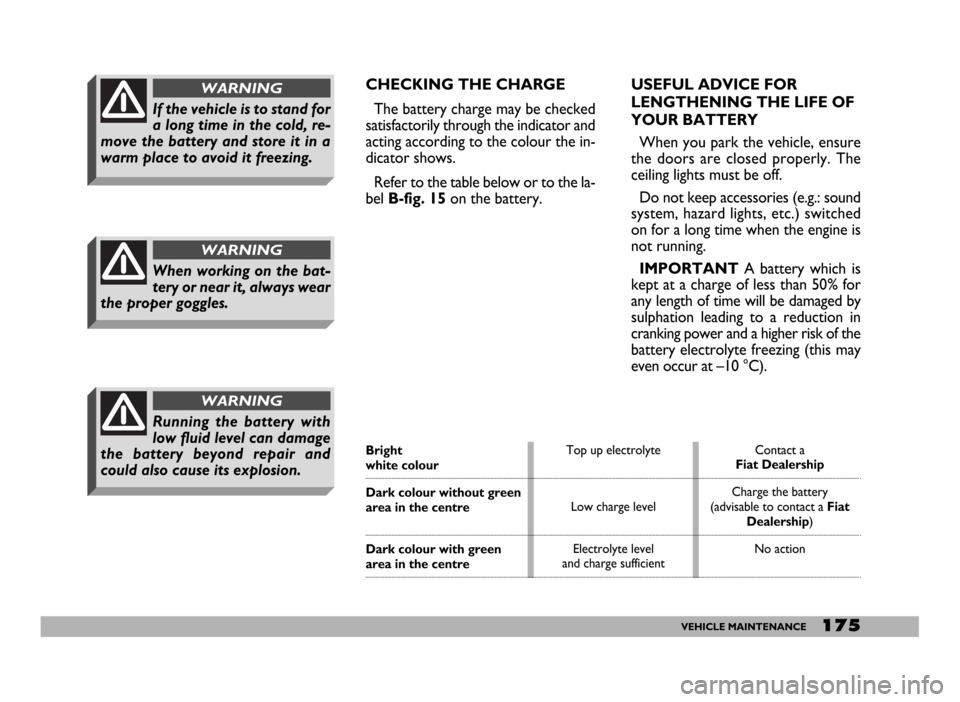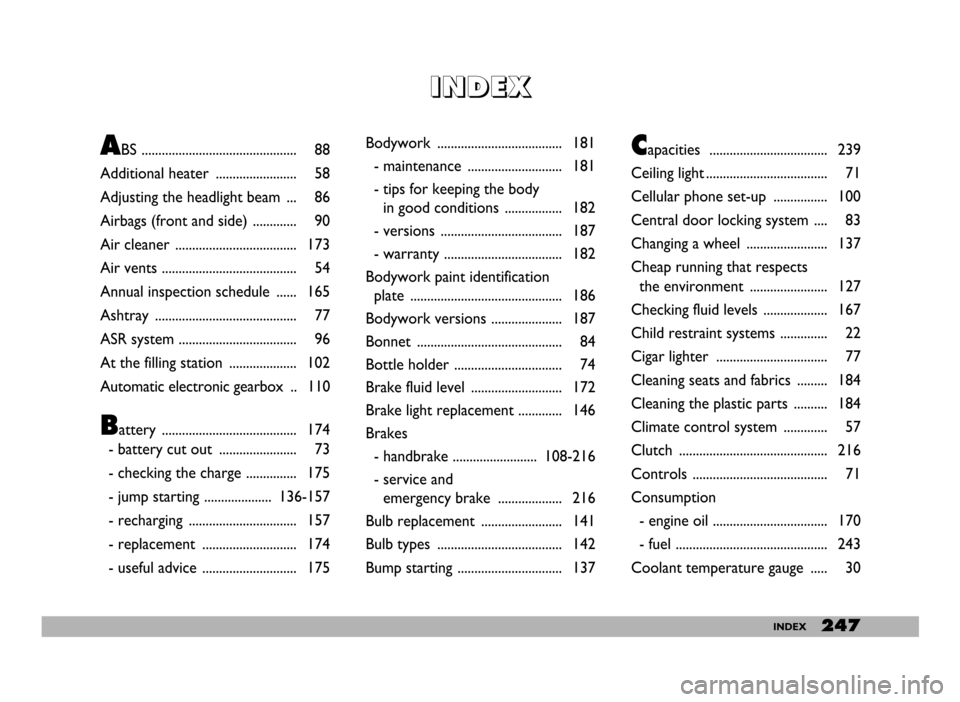2005 FIAT DUCATO 244 door
[x] Cancel search: doorPage 176 of 258

175VEHICLE MAINTENANCE
When working on the bat-
tery or near it, always wear
the proper goggles.
WARNING
Running the battery with
low fluid level can damage
the battery beyond repair and
could also cause its explosion.
WARNING
If the vehicle is to stand for
a long time in the cold, re-
move the battery and store it in a
warm place to avoid it freezing.
WARNINGCHECKING THE CHARGE
The battery charge may be checked
satisfactorily through the indicator and
acting according to the colour the in-
dicator shows.
Refer to the table below or to the la-
belB-fig. 15on the battery.USEFUL ADVICE FOR
LENGTHENING THE LIFE OF
YOUR BATTERY
When you park the vehicle, ensure
the doors are closed properly. The
ceiling lights must be off.
Do not keep accessories (e.g.: sound
system, hazard lights, etc.) switched
on for a long time when the engine is
not running.
IMPORTANTA battery which is
kept at a charge of less than 50% for
any length of time will be damaged by
sulphation leading to a reduction in
cranking power and a higher risk of the
battery electrolyte freezing (this may
even occur at –10 °C).
Bright white colour
Dark colour without green
area in the centre
Dark colour with green
area in the centreTop up electrolyte
Low charge level
Electrolyte level
and charge sufficientContact a
Fiat Dealership
Charge the battery
(advisable to contact a Fiat
Dealership)
No action
Page 183 of 258

182VEHICLE MAINTENANCE
– the use of zinc-plated sheet steel
which is highly resistant to rust;
– the spraying of the underbody, en-
gine compartment, inside the wheel-
houses and other parts with wax-
based products with a high protective
capacity;
– spraying plastic-coating materials
to protect the most exposed points:
under the door, inside the wings, the
edges, etc.;
– the use of “open” box sections to
prevent condensation and water from
building up and rusting the inside of
the parts.
BODY AND UNDERBODY
WARRANTY
Your Ducato is covered by warranty
against any original structural or body
part being perforated by rust. Refer to
the Warranty Booklet for the general
terms.TIPS FOR KEEPING THE BODY
IN GOOD CONDITIONS
Paintwork
The paintwork is not only to make
your vehicle look attractive but also
to protect the steel.
If the paint is scuffed or scratched
deeply you are therefore advised to
touch up as necessary to prevent rust
from forming.
Only use genuine products when
touching up the paintwork (see sec-
tion “Technical Specifications”).
Ordinary maintenance of the paint-
work means washing it. The frequency
you should do this depends on the
conditions and the environment the
vehicle is driven in.
For example:
– areas with a high level of air-pollu-
tion;
– roads sprinkled with road saltwash;
– parking under trees which drop
resin. In these cases, wash your vehi-
cle more frequently.To wash the vehicle properly:
1)wash the body using a low pres-
sure jet of water;
2) wipe a sponge with a slightly
soapy solution over the bodywork,
frequently rinsing the sponge;
3) rinse well with water and dry
with a jet of air or a chamois leather.
When drying the vehicle, be careful
to get at those parts which are not so
easily seen, e.g. the door frames, bon-
net and around the headlights where
water can most readily collect. You
should leave the vehicle out in the
open so that any water remaining can
evaporate more easily.
Page 244 of 258

243TECHNICAL SPECIFICATIONS
FUEL CONSUMPTION - CO2EMISSIONS
RUNNING AND USE CONDITIONS AFFECTING FUEL CONSUMPTION
(examples and differences with respect to goods transportation vehicle data)
IMPORTANT
Although fuel consumption mea-
surements procedure aim at defining
realistic values, fuel consumption is in-
fluenced by factors such as:
Driving style and vehicle usehigh
speed, frequent acceleration, frequent
gear shifting, door-to-door deliveries,
etc.
Just for passenger transportation
versions with 2.3 and 2.8 JTD engines,
reduced consumption can be obtained
by starting (on level road) in 2nd gear
instead of 1st gear.
Traffic and road conditions
queues, bending roads, steep roads,
bad road surface, etc.Weather conditions and tem-
peratures
low temperatures, thinner air, wind,
rain etc…;
Vehicle conditions
Poor maintenance (tyre pressure, fil-
ters, spark plugs, etc.), damaged body-
work
Load conditions
Heavy weights, not optimal load dis-
tribution, large weights on roof rack,
etc.
Use of electric devices
Climate control, heater and electric
devices in general
Special conditions of use
Special vehicle conditions of use: roof
rack, trailer, open side windows, type
of tyres, etc.Special trim and adaptations
caravan, motor home, mega box, can-
vas cover, etc.
Some of these conditions are illus-
trated in these figures on the next
pages.
For more information, refer to the
advice in the chapter “Cheap running
that respects the environment.
The fuel consumption values shown
in the table in following pages were de-
fined according to the type-approval
specifications in European Directives.
Consumption values are defined by
means of the following procedures:
– an urban cycle: consisting of a
cold start and a simulated drive in city
streets;
– an extra-urban cycle: consisting
in frequent accelerations, in all gears,
Page 248 of 258

247INDEX
I I
N N
D D
E E
X X
Bodywork ..................................... 181
- maintenance ............................ 181
- tips for keeping the body
in good conditions ................. 182
- versions .................................... 187
- warranty ................................... 182
Bodywork paint identification
plate ............................................. 186
Bodywork versions ..................... 187
Bonnet ........................................... 84
Bottle holder ................................ 74
Brake fluid level ........................... 172
Brake light replacement ............. 146
Brakes
- handbrake ......................... 108-216
- service and
emergency brake ................... 216
Bulb replacement ........................ 141
Bulb types ..................................... 142
Bump starting ............................... 137Capacities ................................... 239
Ceiling light .................................... 71
Cellular phone set-up ................ 100
Central door locking system .... 83
Changing a wheel ........................ 137
Cheap running that respects
the environment ....................... 127
Checking fluid levels ................... 167
Child restraint systems .............. 22
Cigar lighter ................................. 77
Cleaning seats and fabrics ......... 184
Cleaning the plastic parts .......... 184
Climate control system ............. 57
Clutch ............................................ 216
Controls ........................................ 71
Consumption
- engine oil .................................. 170
- fuel ............................................. 243
Coolant temperature gauge ..... 30ABS .............................................. 88
Additional heater ........................ 58
Adjusting the headlight beam ... 86
Airbags (front and side) ............. 90
Air cleaner .................................... 173
Air vents ........................................ 54
Annual inspection schedule ...... 165
Ashtray .......................................... 77
ASR system ................................... 96
At the filling station .................... 102
Automatic electronic gearbox .. 110
Battery ........................................ 174
- battery cut out ....................... 73
- checking the charge ............... 175
- jump starting .................... 136-157
- recharging ................................ 157
- replacement ............................ 174
- useful advice ............................ 175
Page 249 of 258

248INDEX
Cruise Control ............................ 68
Current socket ............................ 76
Dashboard ................................. 5
Demisting ...................................... 56
Diesel fuel filter ........................... 173
Differential .................................... 216
Digital clock .................................. 32
Dimensions ........................... 222-224
Dipped beam headlights ............ 65
- bulb replacement ................... 143
Direction indicators ................... 66
- front bulb replacement ......... 145
- rear bulb replacement .......... 146
- side bulb replacement ........... 145
Doors ............................................ 79
- 270° opening ........................... 82
- central door locking .............. 83
- driver’s cab doors .................. 79
- rear door ................................. 81
- remote control ....................... 9- side sliding door ..................... 80
- window regulators ................ 83
Driving style affecting fuel
consumption .............................. 124
Electric windows ....................... 83
Electronic alarm .......................... 11
Electronic automatic gearbox .. 110
Electronic control units ............. 177
- speed limiter ........................... 177
Emergency starting .............. 107-135
Emission control devices ........... 128
Engine ............................................ 214
- starting diesel engines ........... 106
- starting petrol engines .......... 105
- stopping the engine ............... 108
- supply/ignition ......................... 215
- warming up the engine ......... 107
Engine/bodywork codes ............ 187
Engine compartment .................. 183
Engine coolant gauge .................. 30
Engine coolant level .................... 170Engine marking ............................ 185
Engine oil ....................................... 169
- consumption ........................... 170
Engine oil level ............................. 169
Engine oil level gauge ................. 32
EOBD system .............................. 95
Fiat Code (system) ................... 7
First aid kit .................................... 161
Flashing the headlights ............... 66
Fluids and lubricants ................... 241
Front/rear ceiling light
replacement ............................... 148
Front fog light replacement ...... 145
Fuel cut-off switch ...................... 72
Fuel gauge ..................................... 31
Fuses (replacement) ................... 149
Getting to know
your vehicle............................ 5
Getting the best out of
your vehicle............................ 105